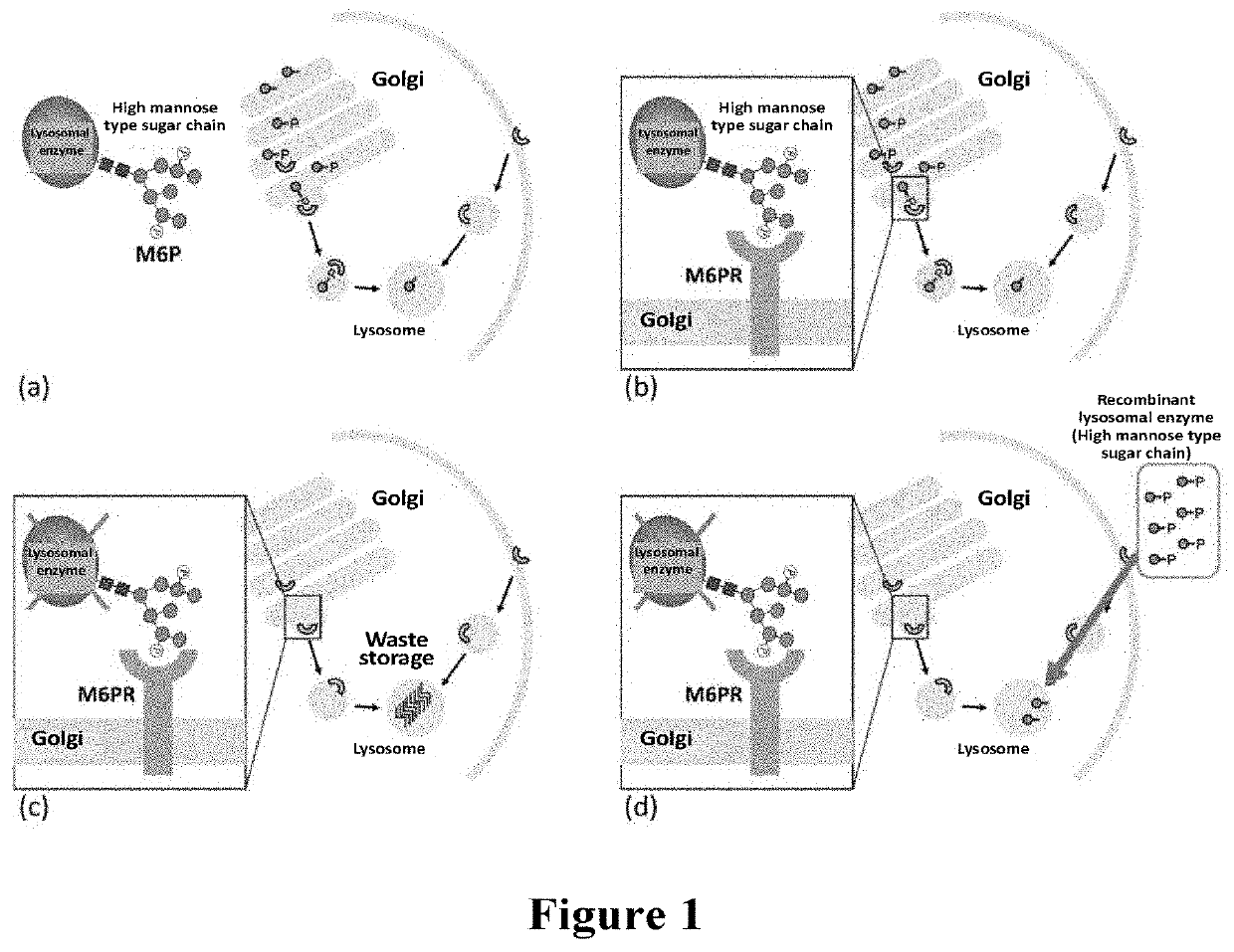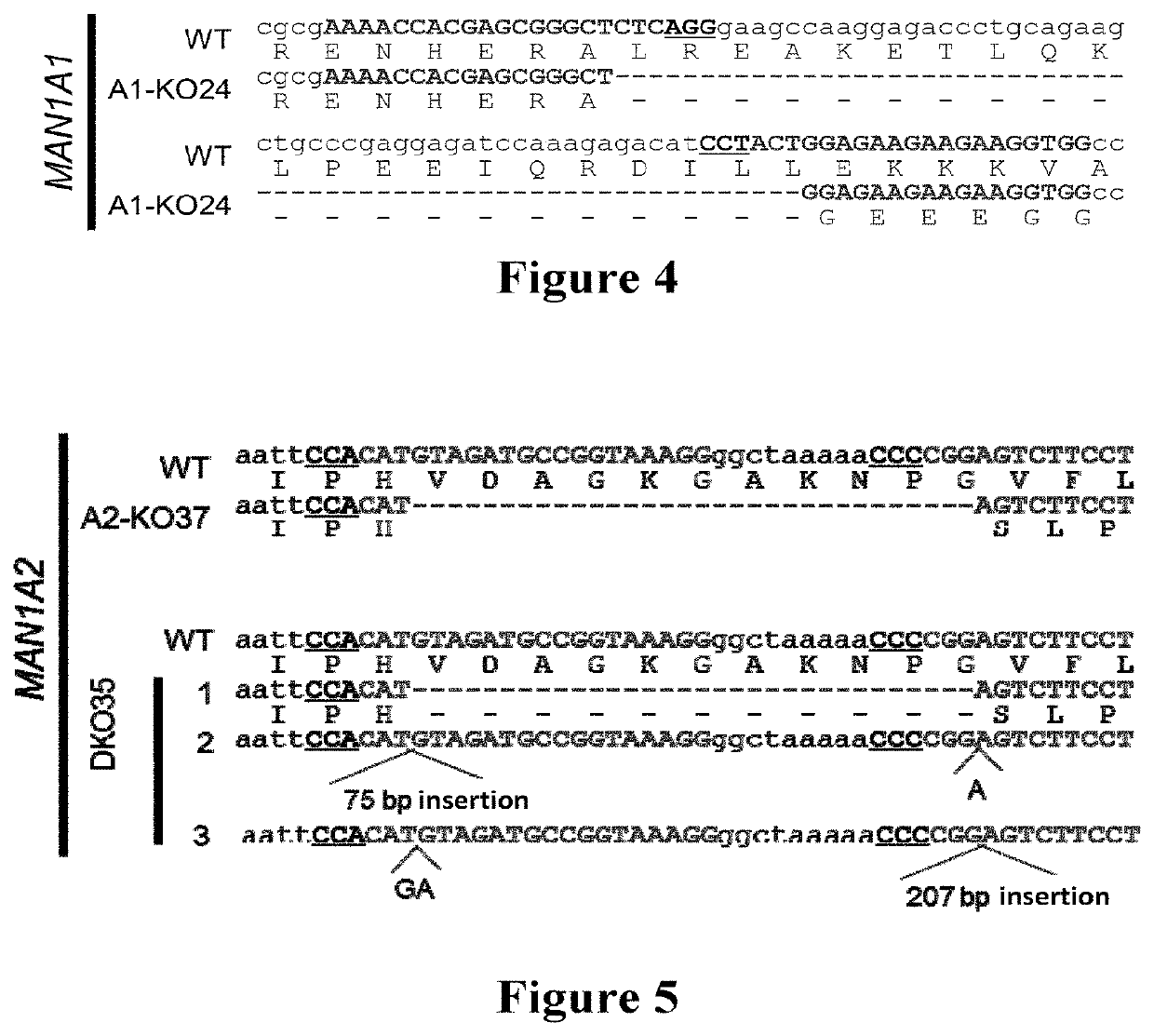Animal cell strain and method for use in producing glycoprotein, glycoprotein and use thereof
a technology of glycoprotein and animal cell, which is applied in the field of animal cell strain and method for producing glycoprotein, glycoprotein and use thereof, can solve the problems of lysosomal storage disease, threatening the lives of patients, and the dysfunction of cells, tissues and/or organs, etc., and achieves excellent stability and safety of glycoprotein, reduced content of complex type sugar chains, and high homogeneity
- Summary
- Abstract
- Description
- Claims
- Application Information
AI Technical Summary
Benefits of technology
Problems solved by technology
Method used
Image
Examples
example 1
[0109]A double knocked-out cell strain of the Golgi a-mannosidase genes (mammalian cell strain: human embryonic kidney cell HEK293) was constructed using the CRISPR-Cas9 (Clustered Regularly Interspaced Short Palindromic Repeats) system.
[0110]1. Construction of the Plasmid for Knocking Out
[0111]Knocking out a gene using the CRISPR-Cas9 technology often requires designing a sequence fragment of 20 bp in length with a PAM site (NGG / NAG) behind the fragment. In this experiment, the gene sequences of two genes MAN1A1 / MAN1A2 to be knocked out were obtained from NCBI (see SEQ ID NOs: 44 and 45, respectively). For the designing of guide-RNA, the DNA sequence of the guide-RNA required to knock out the gene was found on the Michael Boutros lab's Target Finder (http: / / www.e-crisp.org / E-CRISP / designcrispr.html).
[0112]The two target sequences of MAN1A1 and the primer sequences used were:
MAN1A1KO1:(SEQ ID NO: 1)AAAACCACGAGCGGGCTCTCAGGPrimer KO1F:(SEQ ID NO: 2)caccAAAACCACGAGCGGGCTCTCPrimer KO1R:...
example 2
[0124]Analysis of Sugar Chains on the Cell Surface by Flow Cytometry
[0125]After knocking out two genes MAN1A1 / MAN1A2 encoding the alpha-mannosidases in the Golgi apparatus using the CRISPR / Cas9 system, the sugar chains on the surface of the double knocked-out cell strain will change to some extent. This phenomenon was confirmed by two different fluorescently labeled lectins. The lectin PHA-L4-FITC can recognize a complex sugar chain on the cell surface, and the lectin ConA-FITC can recognize a high-mannose type sugar chain on the cell surface. The types of sugar chains on the surface of different cell strains can be compared by staining the cells with lectin. The method was carried out as follows:
[0126](1) inoculating different cell strains in a 6-well plate and allowing them to grow to 100%;
[0127](2) removing the medium and rinsing the wells once with 1 ml of PBS;
[0128](3) adding 220 μl of Tryp / EDTA to digest the cells;
[0129](4) adding 1 ml of fresh 10% FCS medium to harvest the ce...
example 3
Knocking Out Other Genes Related to the Alpha1,2-Mannosidase
[0140]The plasmid for knocking out two genes MAN1C1 and MAN1B1 was introduced into the DKO cells (two knockout target sequences of the MAN1C1 gene and the corresponding primer sequences were set forth in SEQ ID NOs: 13 to 18, respectively, and two knockout target sequences of the MAN1B1 gene and the corresponding primer sequences were set forth in SEQ ID NOs: 19 to 24, respectively), and the plasmid introduced into the cell will express the sequences of the Cas9 protein and the target RNAs. The cells were cultured for about ten days after transfection, and the cell genome was extracted. Since two target sequence sites were designed, the gene sequence on the chromosome was displaced after the gene was knocked out, and the inventors confirmed the knockout of part of the genes (the results were shown in FIG. 8, and the SEQ ID NOs: 29 and 30 represent the primers for the PCR Check of the gene MAN1C1, and SEQ ID NOs: 31 and 32 r...
PUM
| Property | Measurement | Unit |
|---|---|---|
| Fraction | aaaaa | aaaaa |
| Volume | aaaaa | aaaaa |
| Volume | aaaaa | aaaaa |
Abstract
Description
Claims
Application Information
 Login to View More
Login to View More - R&D
- Intellectual Property
- Life Sciences
- Materials
- Tech Scout
- Unparalleled Data Quality
- Higher Quality Content
- 60% Fewer Hallucinations
Browse by: Latest US Patents, China's latest patents, Technical Efficacy Thesaurus, Application Domain, Technology Topic, Popular Technical Reports.
© 2025 PatSnap. All rights reserved.Legal|Privacy policy|Modern Slavery Act Transparency Statement|Sitemap|About US| Contact US: help@patsnap.com



